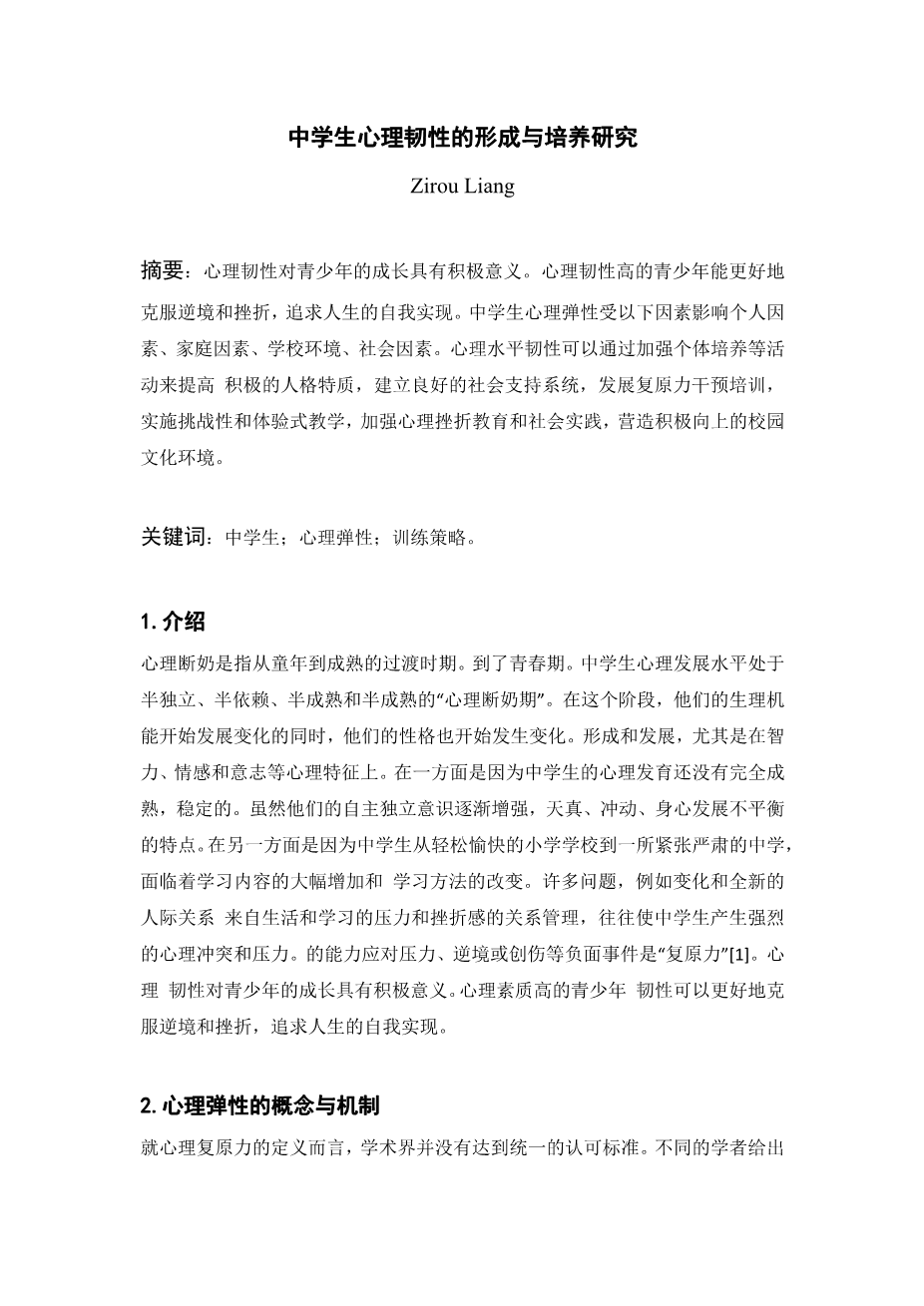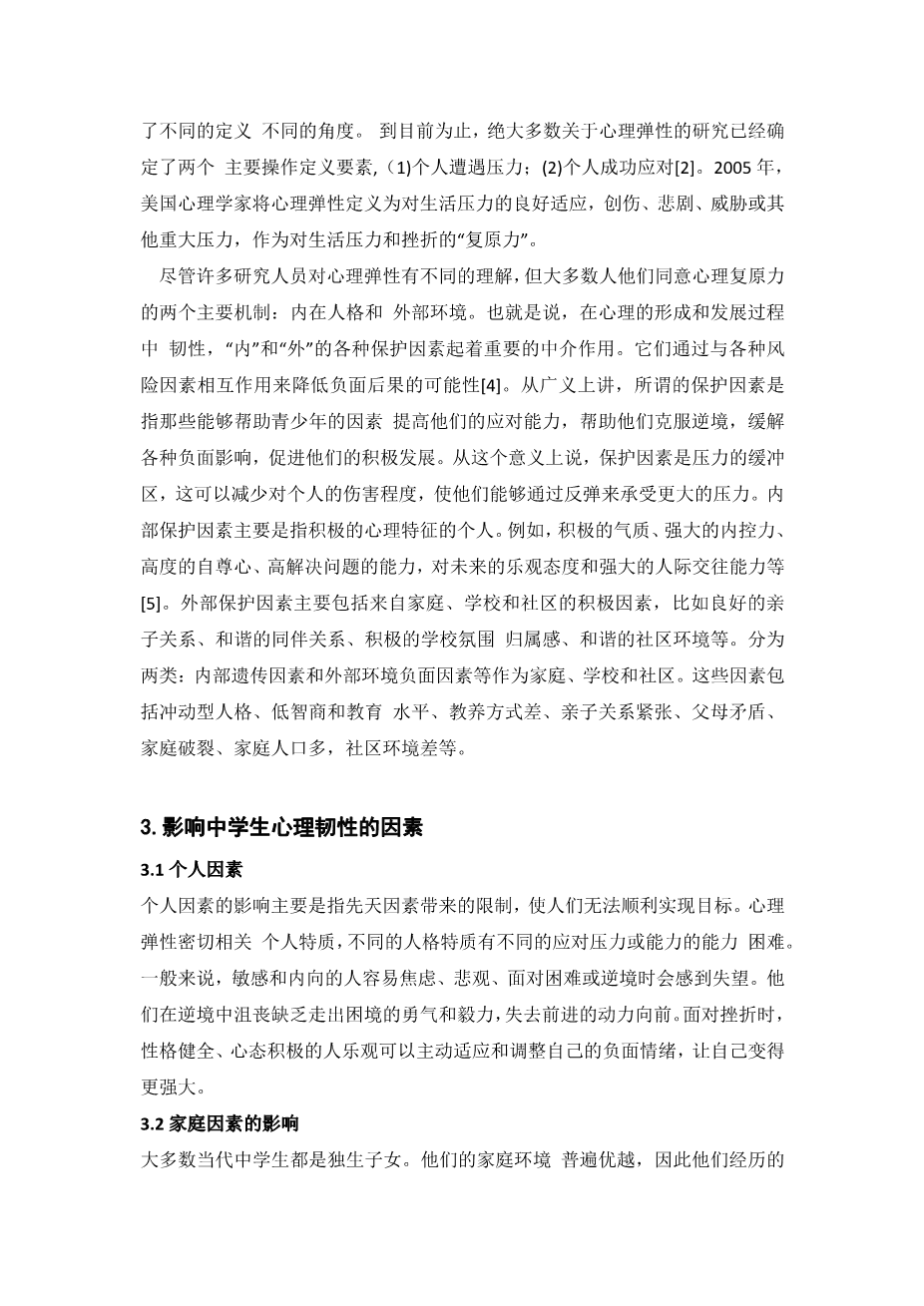中学生心理韧性的形成与培养研究外文翻译资料
2023-04-05 20:48:13
Research on the Formation and Cultivation of Psychological Resilience in Middle School Students
Zirou Liang
Abstract. Psychological resilience is of positive significance to the growth of adolescents. Teenagers with high psychological resilience can better overcome adversity and setbacks and pursue self-realization of life. Middle school studentsrsquo;psychological resilience is influenced by personal factors, family factors, school environment, and social factors. The level of psychological resilience can be improved by those activities such as strengthening the cultivation of individual positive personality traits, building a good social support system,developing resilience intervention training, implementing challenging and experiential teaching, strengthening psychological frustration education and social practice, and creating a positive campus cultural environment.
Keywords: middle school students; psychological resilience; training strategies .
1. Introduction
Psychological weaning refers to the transition period from childhood to maturity in the period from adolescence to early youth. The psychological development level of middle school students is in a semi-independent, semi-dependent, semi-mature and semiimmature 'psychological weaning period'. At this stage, while their physiology begins to develop and change, their personality also begins to form and develop, especially in mental characteristics such as intelligence, emotion, and will. On the one hand, it is because the mental development of middle school students is not yet fully mature and stable. Although their autonomy and independence consciousness is gradually increasing, they have the characteristics of naivety, impulsiveness, and unbalanced physical and mental development. On the other hand, it is because middle school students have changed from a relaxed and pleasant primary school to a tense and serious secondary school, facing a substantial increase in learning content and a change in learning methods. Many problems, such as change and brand-new interpersonal relationship management, which come from the pressure and frustration of life and learning, tend to make the middle school students have strong psychological conflicts and pressures. The ability to cope with such negative events as stress, adversity or trauma is 'resilience' [1]. Psychological resilience is of positive significance to the growth of adolescents. Teenagers with high psychological resilience can better overcome adversities and setbacks and pursue self-realization of life.
2. The Concept and Mechanism of Psychological Resilience
As far as the definition of psychological resilience is concerned, the academic community has not yet reached a unified standard of recognition. Different scholars give different definitions from different angles. So far, the vast majority of studies on psychological resilience have identified two main operational defining elements: (1)individual encounter stress; (2) individual successful coping. [2] In 2005, American psychologists defined mental resilience as a good adaptation to life stresses, traumas, tragedies, threats or other major stresses, as a 'resilience' to life stresses and setbacks.
Although many researchers have a different understanding of psychological resilience, most of them agree with the two main mechanisms of psychological resilience: internal personality and external environment. That is to say, in the process of formation and development of psychological resilience, various protective factors of 'internal' and 'external' play an important intermediary role. They reduce the possibility of negative consequences by interacting with various risk factors. [4] Broadly speaking, the socalled protective factors refer to those factors that can help adolescents improve their coping ability, help them overcome adversity, alleviate various negative effects and promote their positive development. In this sense, protective factors are buffer zones of pressure, which can reduce the degree of injury to individuals and make them able to withstand greater pressure by rebounding. Internal protective factors mainly refer to the positive psychological characteristics of individuals. For example, positive temperament, strong internal control, high level of self-esteem, high problem-solving skills, optimistic attitude towards the future and strong interpersonal skills, etc. [5]. External protective factors mainly include positive factors from family, school and community, such as a good parent-child relationship, harmonious peer relationship, positive school atmosphere and a sense of belonging and harmonious community environment, etc. Risk factors can also be divided into two categories: internal genetic factors and external environmental negative factors such as family, school and community. These factors include impulsive personality, low IQ and education level, poor parenting style, tense parental relationship, the conflict between parents, broken families, large population families, and poor community environment, etc.
3. Factors Influencing Middle School Studentsrsquo; Psychological Resilience
3.1 Personal Factors
The influence of personal factors mainly refers to the restrictions brought by congenital factors, which ma
剩余内容已隐藏,支付完成后下载完整资料


英语译文共 7 页,剩余内容已隐藏,支付完成后下载完整资料
资料编号:[590532],资料为PDF文档或Word文档,PDF文档可免费转换为Word




